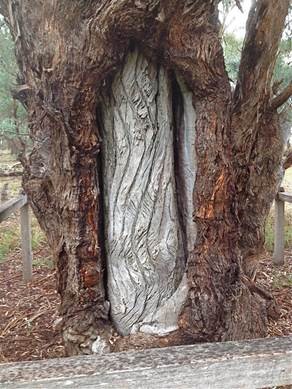Ground-breaking research on a Wiradjuri burial site at Molong, could soon reveal new insights into traditional funeral practices, highlighting the importance of Aboriginal cultural heritage in the Central Tablelands region of NSW.

Central Tablelands Local Land Services and La Trobe University this week are undertaking radar technology to research ancient customs on the Garra Travelling Stock Reserve (TSR) south east of Molong.
The La Trobe university archaeology team are using ground penetrating radar to locate burial sites, focusing initially on a carved tree, believed to mark the grave of a highly respected Aboriginal man.
"Carved trees were generally reserved for special individuals, that we refer to as a man of high degree," explained Wiradjuri man and Senior Land Services Officer (Indigenous Communities), Greg Ingram.
"Once the burial spot has been confirmed, the archaeologists will use three-dimensional mapping to survey the area and identify clues about how traditional burials were conducted in the past."
The Local Land Services funded research will include a search for other potential burial sites in the vicinity of the remaining carved tree.
"There are a lot of large stumps at this site," said Mr Ingram.
"It's possible that these stumps may have been carved trees that have been cut down, suggesting this could be a traditional burial ground containing more than one grave site."
Several local Aboriginal organisations are involved in the field work on site, ensuring engagement and partnership in the project with the local Aboriginal community.
"There hasn't been a lot of research on traditional Wiradjuri funeral practices, so this is a significant project," said Mr Ingram.
"This tree was carved by local Wiradjuri people as part of what was likely a deeply solemn ritual to honour an individual they held in very high esteem."
"It's important to us that the descendants of these people are now able to oversee this research on what must be very special place."
Local Land Services is responsible for the care, control and management of a vast network of TSRs in NSW, including the Garra Reserve.
Working with the Orange Local Aboriginal Land Council, back in 2018 Central Tablelands Local Land Services fenced off the location on the Garra TSR to stop sheep and cattle from damaging the site.
"It's worth noting that this reserve has been leased to a local landholder for many years, and while we have fenced off a small section to protect and preserve a special site, the remainder of the reserve has continued to be used for grazing stock," said Mr Ingram.
"Aboriginal cultural heritage and western farming practices can co-exist, they don't have to impact on your usual land management."
"We've taken a collaborative approach to exploring traditional knowledge and we've been able to demonstrate that Aboriginal culture can be preserved working side by side with landholders and local communities."
Central Tablelands Local Land Services has a strong working relationship with local Aboriginal communities and is committed to preserving and promoting Wiradjuri cultural heritage.
The three-dimensional mapping employed during the Garra TSR project will be used to create educational tools to promote local Aboriginal Cultural Heritage and to train Local Land Services staff in cultural awareness.
Landholders seeking advice or assistance regarding managing and protecting Aboriginal Cultural Heritage are urged to contact their nearest Local Land Services office.






